
lineage 3: twin lens reflex

lineage 3: twin lens reflex |
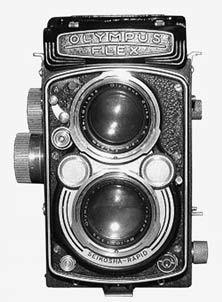
Flex B1 2.8 - First model 1951 |
Olympus Flex B1 Premiere Model; Production Period unknown but likely to be late 1951 ~ June 1952. Extremely rare £650.
INTRODUCTION: I recently found the website of a Japanese collector and researcher: Mr E. Suzuki. Reading the translated pages filled me with delight as, for the first time, I began to understand some of the mysteries surrounding the first OlympusFlex TLR that have baffled me for years. This is the only reference source I have found that provides definitive proof that the first B1 was equipped with a rather special viewing hood; unfortunately soon dropped, probably due to (Rollie) copyright issues. Mr Suzuki tells us that the 1951 Flex B1 has a mirror inside the hood attached to the top window, which hinges down to 45º to allow horizontal eye level viewing through a lens in the back of the viewing hood. You can see the mirror mounting tabs showing on the front elevation just above the OLYMPUSFLEX insignia. Also of note is the lens and serial number format being different and, unusually, 7 digits rather than the standard 6 digits. These are also unusually prefixed viz: "No. XXXXXXX". The image opposite is taken from Mr Suzuki's site - URL below. |
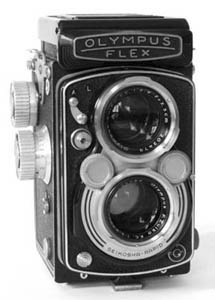
Flex B1 2.8 - Second model |
OlympusFlex Model B1 (2). August 1952 ~ October 1952. Very rare £550.
The first incarnations of Mr Sakurai's design challenged the West's best TLR of the day with its twin f=2.8 viewing and taking lenses. The taking lens is marked as F Zuiko (6 elements) but the viewing lens is not designated and is probably a D Zuiko (4 elements). A Shiekosha-Rapid shutter speeded 1~400 + B. Two front-plate mounted wheels adjust shutter and aperture. There is no read-out window, the wheels are suitably marked on their edges. This design was in direct competition with the best from the German maker Rollie at the time. the first three models are generally known as RollieFlex copies because of their use of 'click' wheels for shutter/aperture adjustment rather than the cheaper sliders that will follow.
|
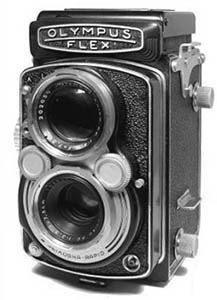
Flex B2 3.5 taking lens |
OlympusFlex B2 3.5 model. October 1953 ~ November 1955. Extremely Rare £600-700
The third 'RollieFlex' copy is the Flex B2 which is identical to the B1 in every respect except the taking lens is now a f=3.5. Mr Sakurai acknowledged the F Zuiko 2.8 fitted to the B1 model was a little too soft for corner to corner sharpness across the 6cm negative. This particular incarnation is expecially difficult to find even though it has been assumed to be in production for 14 months. Lens and serial number format returns to the normal 6 digits with no prefix. This is paricularly difficult to find and also highly prized as the results from the 3.5 lens are significantly better than the softer 2.8. Images of this camera are also rare; this one again comes from Mr Suzuki's site. Those wanting to do research themselves need to copy this URL into their browser: http://www.geocities.co.jp/Hollywood-Kouen/3530/special/special04.htm
|
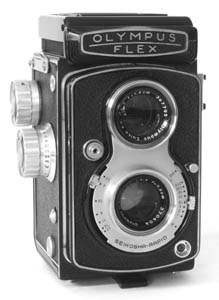
Flex A 3.5 without bayonets |
OlympusFlex A 3.5. November 1954 ~ August 1956. Rare £300
The first of the 'RollieCord' copies, the OlympusFlex model a 3.5 has twin D Zuiko (not marked as such) lens pods in a Shiekosh-Rapid Shutter speeded 1~500 + B. For reasons unknown, other than economy, the bayonet fittings around the lens pods are dropped in favour of threaded nacelles. Very plain looking TLR.
|
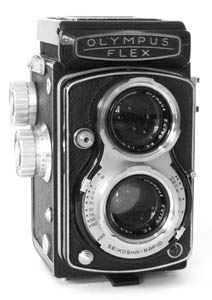
Flex A 2.8 |
OlympusFlex A 2.8. November 1955 ~ August 1956. Very Rare £350
A return to the design aspirations of 1952 sees twin FC Zuiko f=2.8 lens pods with bayonet rims in a Shiekosha-Rapid Shutter speeded 1~500 + B. As with the other 'RollieCord' copies shutter speed and aperture settings are altered via sliding levers mounted around the shutter block.
|

Flex A 3.5 model 2 |
OlympusFlex A 3.5 model 2. June 1956 - September 1957. Rare £250
The final model in the TLR series. Fitted with twin 75mm x f=3.5 Zuiko FC lens pods with bayonet rims in a Seikosha MX shutter speeded 1~500 + B. Flash synchronisation now M F or X. As with all other 6x6 Flexes the shutter is inelegantly cocked with a stubby lever falling to the users left hand.
|
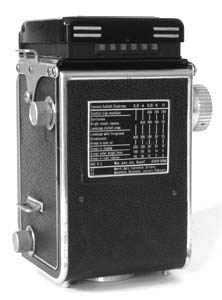
Rear of B1 with exposure guide plate. |
Exposure Guide Plate:
I can confirm the presence of the Exposure Guide Plate on my examples of models B1 (marked for 2.8 lens) and A 3.5 model 2 (marked for 3.5 lens) only. My examples of the Flex A2.8 and A3.5 have no such plate mounted on the film door. However, these plates were generic at the time; it may have been down to individual factory lines as to whether these were fitted. Note too from this image the film door on the B1 is edged with a polished finish rolled flute rather than black enamelled as later.
|

OEM Combined lens protectors |
Lens Protectors; as supplied with camera. Very rare. £20-£70
As you can see there are at least two types of bayonet fit lens protectors. The first models, the B series, were supplied with the fancy marked and hinged-in-the-middle type. These are exceptionally rare; I've seen only 2 in my collecting years. The second and ridgid type are not as rare and were supplied for the A series bayonet TLR's in two sizes; 2.8 and 3.5. The third type is a 'push-over' type to fit only the A-3.5 model; I have never seen this particular derivative. Substantial leather cases were also provided with drop down fronts. A large flash gun was available; all Flexes are fitted with heavy machined aluminium shoes on the left hand side (in use). |
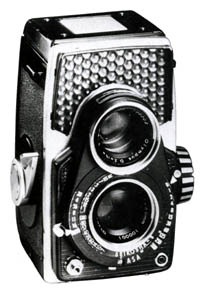
EyeFlex B 2.8 |
Olympus Eye-44 B 2.8. February 1959 (Prototype). Not released. £XXXX
In a final gesture to TLR's which were already losing popularity as the 35mm compact takes over the world, Mr Sakurai designs the semi-automatic EyeFlex in the 4cm x 4cm format, beloved of Rollie in their Grey Baby. Fitted with 60mm x f=2.8 F Zuiko lens pods in a Seikosha-S shutter speeded 1~500 + B this camera though prototyped was never made commercially. |
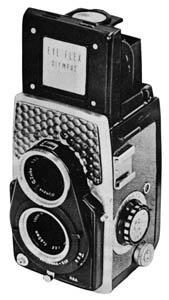
EyeFlex A 3.5 |
Olympus Eye-44 A 3.5. February 1959. Extremely Rare £750-£1000
Eye-44 model B is a less well specified, but almost fully automated version of the high tech Eye-44 B. Also equipped with the 'Magic Eye' Bell & Howell type selenium meter-behind-honeycomb glass it is fitted with 60mm x f=3.5 Zuiko pods in a Seikosha-SLV shutter with few manual settings. According to Mr Sakurai in his one of his interviews for VisionAge he recalls that 'some Eye-44 B models were released to gauge public response.' This makes any surviving EyeFlex one of the rarest cameras from Olympus. |
|
|
|
HOME |
INTRO |
BOOKS |
OLYMPUS CIRCLE |
QUEST |
TOC MEMBERS |
GALLERIES
|
| Posted 2004/12/12 | Copyright © 2004 John Foster |